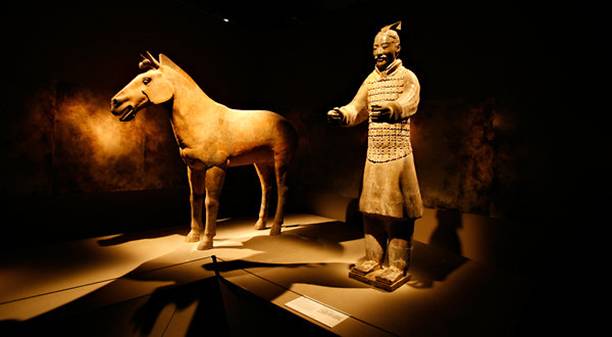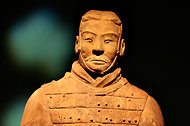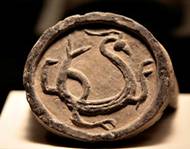秦始皇帝已不在,兵马俑继续前行
导读:‘Terracotta Warriors’ at Discovery Times Square’ 兵马俑现身纽约时代广场
 |
In “Terracotta Warriors,” a life-size charioteer and horse from the third century B.C.
兵马俑—一个真人大小的战车御夫和他的战马(公元前3世纪)
Two millenniums ago, when the last shovelful of dirt fell on China’s terra-cotta soldiers, the thought was that they would be seen in this life no more. Buried in an emperor’s tomb, they would thenceforth secure and patrol imperial turf in the afterlife.
两百年前,当最后一铲泥土落下时,世人皆以为这些中国兵马俑此生都不会被再看到。这些埋葬在皇帝墓穴中的兵马俑会在来世保卫和守护帝王的疆土。
 |
Terracotta Warriors兵马俑
 |
A pre-Qin dynasty roof tile. 一块先秦时代的屋瓦片
Fate had other plans. Since being exhumed in the late 20th century the same soldiers have been on a global Long March, moving from one sold-out museum appearance to the next, and serving as, among other things, emblems of China’s neo-imperial clout in the here and now.
命运总是不尽如人意。自20世纪晚期被掘出以来,同一个兵马俑---作为中国古代君王权威的象征,就已经踏上了全球性的长征,辗转于一个又一个满座的博物馆.
That army, or a small piece of it, has just arrived in New York City in an exhibition called “Terracotta Warriors: Defenders of China’s First Emperor” at Discovery Times Square. Only nine of the estimated 8,000 figures entombed at Xian in central China have made the trip. But they’re in great shape and, fitted out with weapons, armor, livestock, cash and a portable kitchen, they’re a sight to see.
这个已经抵达纽约时代广场并进行展出的军队,或者只是其中之一就是兵马俑:中国第一位皇帝的守卫军。8000多埋葬在中国中部西安的兵马俑中仅有9个参与这次巡展。但是,这些兵马俑身型壮硕并配备有兵器,铠甲,牲畜,钱币和一个袖珍厨房,真是难得一见的奇观。
They also come with an action-adventure narrative, part deep history, part archaeological romance. The history goes back to well before the third century B.C., when north-central China was a chaos of feuding states, all intent on domination. The one called Qin, ruled by horse breeders whose main trade came to lie outside China, seemed least likely to succeed. But when, after centuries of clashes, the dust finally settled, the Qin was left standing, and in command.
这些兵马俑都是富有传奇色彩的故事,一部分源于深厚的历史,一部分源于考古奇迹。追溯历史到公元前3世纪,当时华北大地处于一片混沌的敌对状态,各国都意图控制大局。其中游离于中国大地外部的游牧国家--秦国似乎是最不可能完成这项任务的。然而,几个世纪的征战后,尘埃最终落定,秦国征服各国,使其听命。
Its leaders were almost absurdly ambitious.
秦国君王太过野心勃勃。
Forget about being big fish in a small territorial pond. They wanted to fill and control the biggest pond, China itself, then considered the center of the world, and made quick progress toward this goal.
忘记自己只是小池中的一条大鱼。他们妄图占领并操控最大的池子—中国,被认为是世界中心,并朝着这一目标迅速迈进。
Victories bred further ambitions. Why stop at China? Why not rule the cosmos,?
胜利总会让人滋生更大的野心。为何止步于中国呢?为何不统治整个宇宙呢?
That was the aim of the penultimate and greatest Qin ruler, Ying Zheng, who was born in 259 B.C., assumed the throne at 13 and bestowed on himself a freshly invented title: Qin Shihuangdi, or First Emperor of Qin, which really meant first emperor of China. Power, for him, was the elixir of life. He couldn’t get enough, and seemed neurotically afraid to stop trying.
这就是最伟大的秦国君王—嬴政的目标。秦嬴政生于公元前259年,13岁即位,后自封称号-秦始皇帝,即秦国的第一位皇帝。
Having subdued immense tracts of China’s geography he set about conquering its history too. He gave orders that all chronicles other than those that flatteringly documented the Qin family line be destroyed. Once he had the past under his thumb, he turned a control-freak eye to the future: he would colonize heaven.
已经征服了中国辽阔疆土的秦始皇开始改写历史。他下令焚烧毁灭除讴歌秦王朝历史篇章外的所有史志。他认为只要他将过去玩于鼓掌就能够掌控未来:他就能统治天下。
This he did, or tried to, by creating one of the most ambitious monuments to self on record: a tomb complex more than 40 years in the making — it was still under way when he died at 50 — that reproduced, to scale and in imperishable form, imperial life as he knew it on earth.
他所做的或试图要做的就是通过创造一个最具野心的丰碑来铭刻自己:一个花费40多年时间建造,并在他50岁驾崩之时仍在修建的墓穴,这个按比例建造的不可磨灭的墓穴再现了秦始皇真实的帝王生活。
Empires can’t exist without armies, so he commissioned one made up of thousands of fighters, from five-star generals to humble foot soldiers, modeled from clay, roughly life size, ready to serve. Each figure was dressed by rank, though with uniforms individually customized: an extra sash here, a bulkier coat there. Faces were differentiated too. Although a very limited number of facial molds were used, each face was given hand-modeled features — noses, ears, mouths, moustaches and so on — so that no two looked alike.
为帝王者必有军队,因此秦始皇打造成千上万的秦俑,从五级将军到低等步兵,以粘土成模,大致为真人大小,随时待命。每个秦俑均按级别穿戴量身定制的服制:有的佩戴腰带,有的身着厚重外套。面部特征也各有特点。尽管使用的面部模具数量有限,但每张面孔有各自的面部特征-鼻子,耳朵,嘴巴,胡须等等,因此没有任何2张面孔是相同的。
- 频道推荐
- |
- 全站推荐
- 推荐下载
- 网站推荐


















